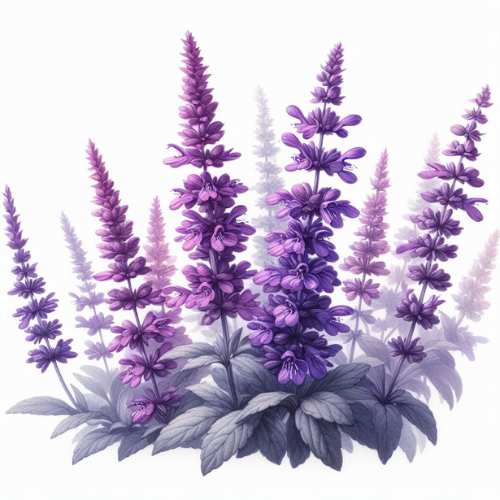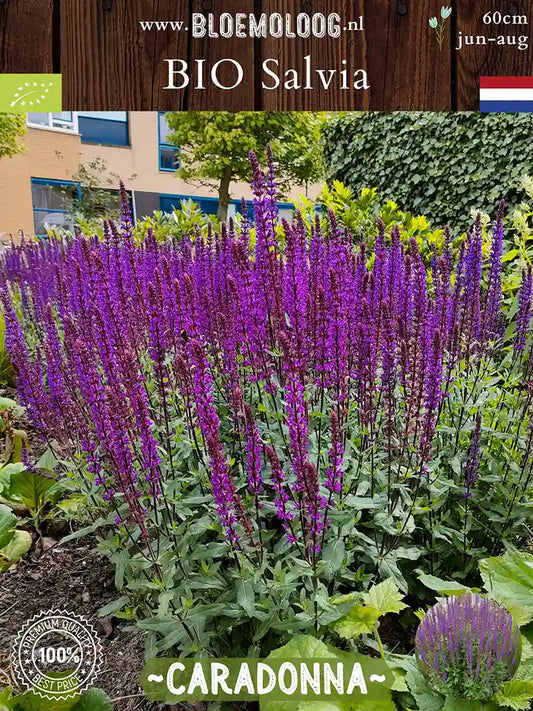
Summer bloomers
-
Organic Salvia nemorosa 'Caradonna' - Woodland sage
Regular price €4,95Regular price -
Organic Salvia nemorosa 'Schneehügel' - White Woodland Sage
Regular price €4,95Regular price
Collection: Organic Sage
Organically grown sage
The Salvia nemorosa also called 'woodland sage', blooms with long sturdy flower spikes of about 60 centimeters high. The flowers themselves consist of numerous small purple or white lipped flowers that are in dense flower clusters, which are known to be a real magnet for pollinators such as bees.
The leaves are lanceolate, which means they are elongated and pointed. The leaves have a light hairiness which gives them a soft appearance. The scent of the leaves is spicy and aromatic. Adding Salvia nemorosa to your garden can therefore not only be visually appealing, but also sensorially appealing because of the scent.
Salvia flowers from June to August and in good weather conditions they can flower again in the autumn if the faded flower stems are cut off.
Can I use Woodland sage as a herb?
The herb sage is popular in the kitchen, for example in salads or warm dishes, because it has many good properties. This also applies to the purple 'Caradonna' and the white 'Schneehügel' forest sage.
Tea can be made from the fresh and dried leaves of salvia. This has a beneficial effect on respiratory diseases such as asthma.
White sage is widely used as incense.
How, where and when do I plant woodland sage?
Salvia nemorosa is a perennial plant that can be planted all year round. The rhizomes can be planted immediately after receipt. Plant all roots so deep that the young green leaves are just above the ground.
Plant in a sunny spot in well-drained soil. Sandy or loamy soils are ideal as they drain excess water and keep the roots healthy. Heavy clay soils can become too soggy and the plants can be susceptible to root rot. Improving the soil structure by adding organic matter such as compost can improve drainage.
Plant it in the middle of the border or in pots, together with the slightly lower ones Oxalis deppei 'Iron Cross' .
Caring for the woodland sage
Provide plenty of water, especially during dry spells, and consider using a layer of mulch around the plant to retain moisture.
After the first bloom in the summer, the faded flower stems are cut back for a possible second bloom in the fall. The following spring, the dead or damaged parts can be removed to stimulate new growth.
Give a balanced feed annually for best results. For organic potting soil, plant food and other soil improvers we recommend Bio Kultura on!
Propagation
After 5 years, the rhizomes can be divided. (This can also be done earlier, but we recommend doing this every 5 years.) Tear or cut the root into smaller pieces and distribute them elsewhere in the garden. This will rejuvenate the plant and allow it to grow well again.
Origin of the Salvia
Salvia is a large genus of flowering plants in the Lamiaceae family. The genus Salvia contains over 900 species worldwide and is native to various parts of the world, including Europe, Asia, North and South America, Africa, and the Middle East. They grow in a variety of environments, from dry deserts to humid forests.
Origin of the woodland sage
Salvia nemorosa is native to southeastern Europe and western Asia. It occurs in countries such as Bulgaria, Romania, Turkey and parts of the Caucasus. It feels at home in various environments, such as open woodlands, grasslands and along the edges of woodlands. The name 'nemorosa' is derived from the Latin word 'nemorosus' which means 'wooded'.
Buy sage
From January to June, organic woodland sage can be ordered at Bloemoloog.nl.
Estimated Shipping Widget will be displayed here!
-
Organic summer bulbs
Summer flowering bulbs and tubers are a promising and colourful addition to gardens, bringing them to life during the warmer months. Here you will find a wide range of flowers and plants that are planted in spring and produce beautiful flowers throughout the summer and autumn.
Planting summer bloomers
Planting summer flowering bulbs and tubers usually requires some preparation in the spring. They thrive in well-drained soil and generally require full sun or light shade.
Pre-growing flower bulbs
You can also choose to grow the frost-sensitive summer bloomers indoors from March, which is called pre-growth. The plant then has a head start and will flower earlier. You then place the pot in a light place in your room and keep the soil slightly moist. As soon as the night frost has gone, the pot can be placed outside or the flower bulb or tuber can be removed and replanted in the open ground. In that case, first keep the pot in a bucket of water for half a day and then plant the tuber in the open ground.
Caring for summer bloomers
Regular watering and removing faded flowers can prolong flowering. All summer flowering plants we offer can be cut back to the ground in the fall. For further instructions, we recommend reading the respective product descriptions for correct wintering.
For organic potting soil, plant food and other soil improvers we recommend Bio Kultura !
Summer buzzers
The entire range of the Bloemoloog is organically grown. This means you don't have to worry about whether it contains harmful substances for beneficial insects such as bees and other summer buzzers.
-
What summer bloomers are there and how do you choose the right one?
There are many different types of summer bloomers, including annuals and perennials, also known as perennials. Annual summer bloomers bloom for only one season, while perennials grow and flower for several years. Some need to be dug up before the cold winter, while others, with proper care, can remain in the same spot for years.
When choosing summer bloomers, it is important to consider the specific needs of the plants, such as water requirements, soil type and care.
Below we discuss some popular summer bloomers and provide information on which location is best for them.Non-hardy perennial summer bloomers
Dahlia: Dahlias are a popular choice for summer bloomers and come in many different colors. They thrive in full sun.
Gladioli: Gladioli are perennial, but not winter-hardy. They grow best in full sun.Winter-hardy perennial summer bloomers
Kniphofia: Kniphofia, also known as firecracker, loves plenty of sunlight. Place the plant in a location where it gets at least 6 to 8 hours of direct sunlight per day. A sunny spot ensures the plant grows and blooms well.
Lily: Lilies are perennial summer bloomers that are often planted. These plants thrive in full sun and partial shade.
Peony: Peonies are well-known summer perennials. They thrive in the sun, but for longer blooms, we recommend a semi-shaded spot.




